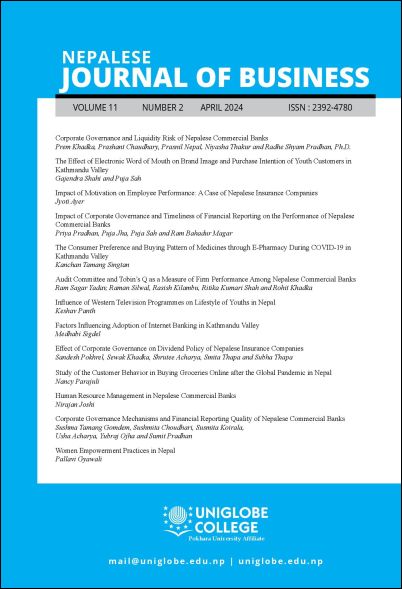Corporate Governance and Liquidity Risk of Nepalese Commercial Banks
DOI:
https://doi.org/10.3126/njb.v11i2.68780Keywords:
cash reserve ratio, credit to deposit ratio, board size, independent directors, female directors, leverage ratio, audit committee, total assetsAbstract
This study examines the relationship between corporate governance and liquidity risk in Nepalese commercial banks. Cash reserve ratio and credit to deposit ratio are selected as the dependent variables. Similarly, board size, independent directors, female directors, leverage ratio, audit committee and total assets are selected as the independent variables. This study is based on secondary data of 18 commercial banks with 108 observations for the study period from 2016/17 to 2021/22. The data were collected from Banking and Financial statistics published by Nepal Rastra bank and the annual reports of respective banks. The correlation coefficients and regression models are estimated to test the significance and importance of corporate governance on the level of liquidity risk in Nepalese commercial Banks.
The study revealed that board size has a positive impact on cash reserve ratio and credit to deposit ratio. It means that increase in board size leads to increase in cash reserve ratio and credit to deposit ratio. Similarly, independent director has a positive impact on cash reserve ratio. It indicates that increase in independent director leads to increase in cash reserve ratio. Likewise, independent director has a negative impact on credit to deposit ratio. It indicates that increase in independent director leads to decrease in credit to deposit ratio. Further, female directors have a negative impact on cash reserve ratio. It shows that higher the female directors, lower would be the cash reserve ratio. In addition, female directors have a positive impact on credit to deposit ratio. It shows that higher the female directors, higher would be the credit to deposit ratio. Likewise, leverage ratio has a positive impact on cash reserve ratio. It shows that higher the leverage ratio, higher would be the cash reserve ratio. Similarly, leverage ratio has a negative impact on credit to deposit ratio. It shows that higher the leverage ratio, lower would be the credit to deposit ratio. Moreover, this study showed audit committee has a negative impact on cash reserve ratio and credit to deposit ratio. It means that increase in audit committee leads to decrease in cash reserve ratio and credit to deposit ratio. Likewise, total assets have a positive impact on cash reserve ratio. It shows that larger the total assets, higher would be the cash reserve ratio. On the other hand, total assets have a negative impact on credit to deposit ratio. It shows that larger the total assets, lower would be the credit to deposit ratio.




